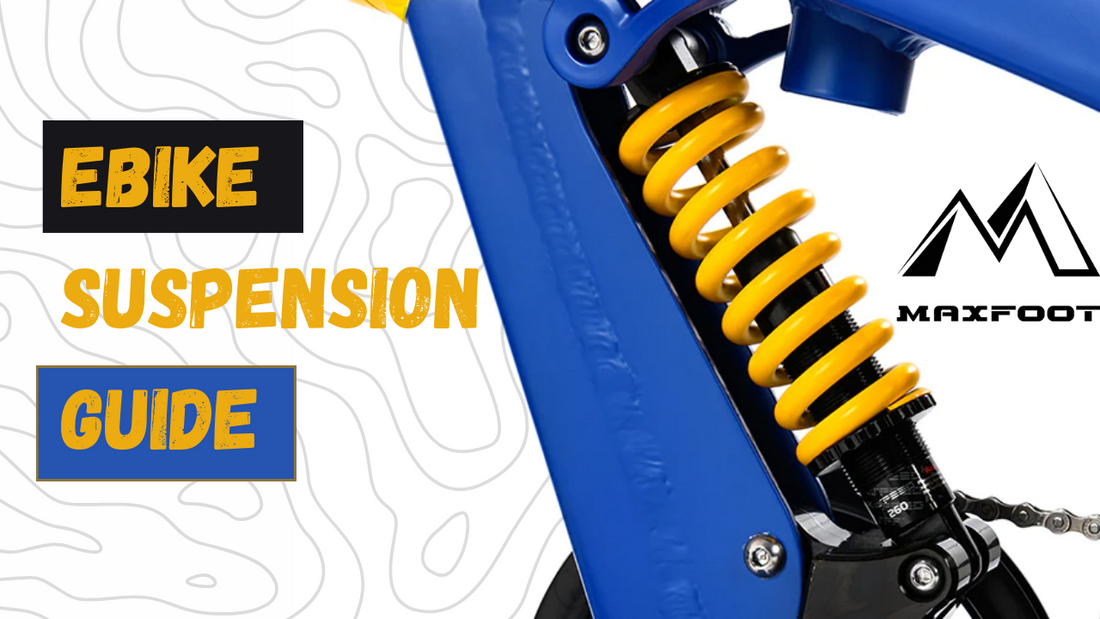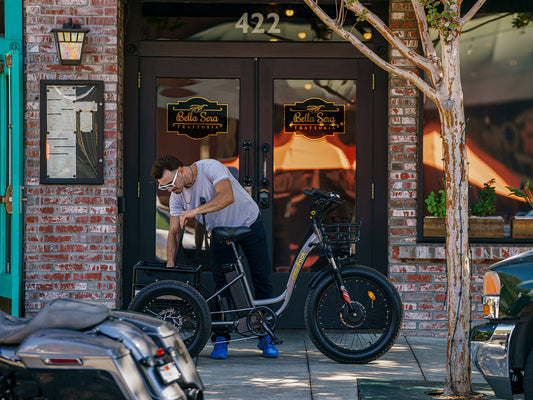Are you an ebike user? Or maybe a geek exploring the anatomy of an ebike? We have got a new topic for you: the ebike suspension system.
In this article, you'll learn something new and exciting. The article is all about the suspension of an ebike – what it’s made of, the different types, and how it’s put together. Plus, we'll share handy tips on keeping it in great shape.
Understanding the Ebike Suspension System
The suspension system in an ebike is like a cushion. It absorbs bumps and shocks from the road. This makes the ride smoother and more comfortable. It also improves bike handling. Good suspension keeps the wheels grounded over rough terrain. This means better traction and safer, more stable rides.
Type of Suspension Mechanisms
In terms of mechanism, we see four types of suspension in bikes: Hydraulic, spring, pneumatic, and rubber. Hydraulic and spring suspensions are among the common ones.
Hydraulic Suspension:
Hydraulic suspension systems are often considered the gold standard. They strike an excellent balance between weight, maintenance, reliability, and shock absorption. The downside? Cost. They are more expensive, and if something goes wrong, repairs or replacements can be a significant expense.
Spring Suspension:
Spring suspensions are quite common, especially in mid-range bikes. They use a metal coil spring to absorb shocks. The biggest advantage of spring suspension is its cost-effectiveness. However, it’s not the lightest option out there.
Resistance Rubber Suspension:
Resistance rubber, or elastomer suspension, is lighter than spring systems and easy to adjust. It requires less maintenance, making it a convenient option. However, the rubber can deteriorate and harden over time, reducing its shock absorption capabilities. When this happens, replacement is necessary.
Pneumatic (Air) Suspension:
Pneumatic suspensions use compressed air to absorb impacts. Imagine how light air is – that’s the key advantage of this system. It’s super lightweight and doesn't suffer from aging issues like resistance rubber. However, air can leak, requiring frequent checks and calibrations to maintain the right pressure.
Major Types of Suspension
Based on placement, and amount, there’s another classification that’s commonly used in the ebike market: Full suspension and Hardtail. Full-suspension bikes have shock absorbers at both the front and rear. This setup excels on rugged, uneven trails.
Hardtail suspension, in contrast, features a front fork only. The rear remains rigid. This design is lighter and often more efficient on smoother trails.
The next sections focus on these two suspensions and their construction in detail.
Hardtail (Front) Suspension: Parts, Travel, and Adjustability

The front suspension is mainly made up of the "fork," which connects the front wheel to the bike's frame. This fork is a complex assembly itself.
Components of the Fork:
A steerer tube is the part that connects the fork to the frame, kind of like a neck connecting the head to the body. The crown is where the two stanchions, the big tubes you see on the front, come together. The stanchion diameter is like the muscles of your fork. Bigger diameter means stronger, more rigid forks that can take a beating on rough terrain.

Inside these stanchions, there may be springs or air chambers, dampers, and oil – all working to soak up those bumps. The sliders or lowers? They are the bits that connect to your front wheel and brakes. And the dropouts are where your wheel's axle snugly fits in.
Suspension Travel:
If you’ve read your ebike manual and checked its specifications, the suspension has something like ‘50mm travel’, written on it. This is the suspension travel. It is the amount of ‘give’ your bike's front end has i.e. how much the suspension can compress under impact before it's fully squished.
Different bikes have different amounts of travel for different purposes. Like, a kid’s bike doesn't need much – just a bit to handle sidewalk bumps. But a mountain bike? That needs a lot more to handle rocky, uneven trails.
|
Type of bike |
Travel (mm) |
Inches |
|
Kid bikes |
30 – 50 |
1 – 2 |
|
Hybrid bikes/commuter ebikes |
60 – 100 |
2 – 3 |
|
Trail bikes /Cruisers |
100 – 120 |
3 – 4 |
|
Mountain bikes |
120 – 160 |
5 – 6 |
There’s another classification based on this travel distance. If it's under 120mm, we call it the short travel suspension, which is great for smoother travel. Over 120mm is the long travel suspension; it’s for hardcore climbing.
Suspension Adjustments
Some fork suspensions let you change the travel length – shorter for climbing hills, longer for descending them. With springs, you can adjust the tension or air pressure to get the perfect balance for your weight and how you ride.
Full-Suspension Ebikes: Front and Rear Suspension Systems

Full-suspension ebikes are the all-terrain vehicles of the biking world, equipped with both front and rear suspension systems. We have already talked about the front suspension, so let's explore the rear suspension, a feature exclusive to full-suspension bikes.
Construction:
The rear suspension is often called the rear shock or just “shock”. It’s tucked away in the main frame triangle, with one end attached to the main triangle and the other to the pivoting rear triangle. This setup allows the rear wheel to absorb impacts effectively.
The designs for rear suspension differ largely from manufacturer to manufacturer. However, they all do a pretty similar job.
Rear Suspension Travel:
Here we have two types of movements: stroke travel and wheel travel. Short travel is how much the rear shock compresses, usually between 1.5” to 3”. It might seem short, but remember, the shock is at the short end of the frame lever, and the rear wheel is at the long end. So, actual wheel travel is much more than short travel. On a full-suspension bike, you can expect the front and rear wheels to have similar travel distances.
Adjustments:
Just like the front one, rear suspension models do have similar adjustment options. However, they’re quite limited compared to the front ones.
No Suspension (Rigid Fork)
An ebike can come without any spring or hydraulic suspension system. In such cases, what you will find is a fixed, rigid fork at both the front and rear. This setup is quite common in entry-level commuter bikes.
On rugged terrain, the ride can be less smooth due to no shock absorption. However, on roads and smooth paths, the lack of suspension is less noticeable, and the ride remains fairly comfortable.
Ebike Suspension Maintenance: Common Issues and Key Tips
In ebike suspension, you need to watch out for the following issues, and seek professional help immediately:
- Oil Leaks:If you notice oil on the stanchions, it could indicate a seal problem. This needs professional attention to prevent further damage.
- Air Loss in Air-Sprung Units:If your suspension is losing air and feels too soft, it's time for a check-up. This could affect your ride quality and control.
- Unusual Noises or Movement:Any knocking sounds or unusual play in the suspension components should be checked out. These could be signs of wear or damage.
For maintenance, these tips may help:
- Protect the Stanchions: Keep the stanchions (the shiny tubes on your fork) free from scratches. Scratches can damage internal parts like seals and bushings, leading to quicker wear and tear.
- Clean Regularly: After each ride, give the stanchions a gentle wipe with a soft cloth and mild cleaner. This helps remove dirt and grime that can cause damage over time.
- Lubricate When Necessary:Check your bike’s manual for specific lubrication recommendations. A bit of lubricant around the seals can keep things moving smoothly.
Maxfoot Ebikes and Their Suspension System
At last, let’s focus on what sets Maxfoot ebikes apart in terms of their suspension systems. Unlike many ebike manufacturers who opt for fixed forks to cut costs and boost profits, Maxfoot takes a different approach. We prioritize rider comfort and performance. That’s why all of our ebike models come equipped with at least a front fork suspension.
Our foldable ebike model, the MF-19, stands out with its full suspension system, providing an exceptionally smooth and comfortable ride. This makes it perfect for a variety of terrains, from city streets to more challenging off-road paths. The MF-19 exemplifies our commitment to quality and rider satisfaction.
|
Maxfoot Bike |
Type of Suspension |
Specs |
|
MF-19 |
Full Suspension |
Six-Bar Linkage Rear Suspension |
|
MF-30 |
Front Hydraulic Suspension |
50mm Max Travel |
|
MF-18 |
Front Hydraulic Suspension |
80-100mm of Travel |
|
MF-17 |
Front Hydraulic Suspension |
80-100mm of Travel |
Ready to experience the difference a Maxfoot ebike can make? Explore our range of models and find your perfect ride today.





1 comment
Is the passenger seat available to purchase separately? If so what is the price?